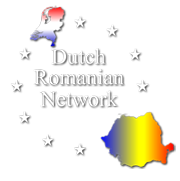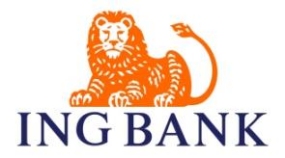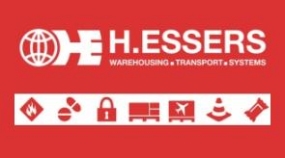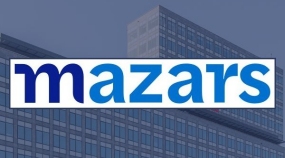Newsletter February 2025

Theft that strikes deep wounds! – Romanian Feelings
 It could hardly have escaped your notice. Saturday, Jan. 25, a very brazen burglary at the Drents Museum robbed four masterpieces that were part of the exhibition Dacia – Kingdom of Gold and Silver. A top exhibition that featured more than 600 objects from the ancient Dacian kingdom, including more than 50 gold and silver treasures. The artifacts were on loan from the Romanian National Historical Museum and are counted among Romania’s National Heritage. “‘The helmet from Cotofeneşti’, made of almost pure gold and dating back to the 5th century B.C., has deep cultural significance in Romania,” journalists from NL Times wrote, in a publication that detailed the theft. “It is more than a theft, it is a very deep wound for the Romanian community,” journalist Claudia Marcu, who visited the exhibition early this month, told Dutch media. She said the impact for Romanians of the theft of heritage pieces would be the same as the theft of Rembrandt van Rijn’s famous painting The Night Watch for the Dutch, News.ro reported. Cornel Colceru, a Romanian translator who has lived in the Netherlands for more than 40 years, spoke about the importance of the Coif of Coţofeneşti to national identity. “Every child in Romania learns about this helmet at school. It is the symbol of the Dacians and their treasures,” he said. The Dutch press notes about the Coţofeneşti helmet that it was probably used in ceremonial rituals, describing the piece as solid gold. “It is the symbolism that makes this artifact extraordinary,” said Drents Museum curator Irini Biezeveld in the NL Times.
It could hardly have escaped your notice. Saturday, Jan. 25, a very brazen burglary at the Drents Museum robbed four masterpieces that were part of the exhibition Dacia – Kingdom of Gold and Silver. A top exhibition that featured more than 600 objects from the ancient Dacian kingdom, including more than 50 gold and silver treasures. The artifacts were on loan from the Romanian National Historical Museum and are counted among Romania’s National Heritage. “‘The helmet from Cotofeneşti’, made of almost pure gold and dating back to the 5th century B.C., has deep cultural significance in Romania,” journalists from NL Times wrote, in a publication that detailed the theft. “It is more than a theft, it is a very deep wound for the Romanian community,” journalist Claudia Marcu, who visited the exhibition early this month, told Dutch media. She said the impact for Romanians of the theft of heritage pieces would be the same as the theft of Rembrandt van Rijn’s famous painting The Night Watch for the Dutch, News.ro reported. Cornel Colceru, a Romanian translator who has lived in the Netherlands for more than 40 years, spoke about the importance of the Coif of Coţofeneşti to national identity. “Every child in Romania learns about this helmet at school. It is the symbol of the Dacians and their treasures,” he said. The Dutch press notes about the Coţofeneşti helmet that it was probably used in ceremonial rituals, describing the piece as solid gold. “It is the symbolism that makes this artifact extraordinary,” said Drents Museum curator Irini Biezeveld in the NL Times.
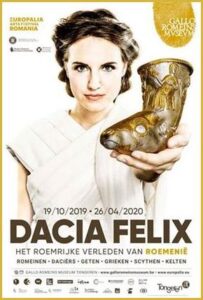 It is hoped that the art treasures will also be properly valued by the thieves. The helmet, for example, weighs only 700 grams and represents a gold value of about 70,000 euros. The insured value of the objects is almost six million euros, but this is in fact a symbolic value, as it was never intended to offer the art treasures at auction. The true value, as Romania’s National Heritage is in fact impossible to determine. The art treasures now stolen were previously on display at the 2019 “Dacia Felix” exhibition at the Gallo-Roman Museum in Tongeren, Belgium on the occasion of Europalia Rom. The editors of this newsletter were involved in this exhibition, which was broader in scope than the current one in Assen. Apparently, security was better there. In March through October 2016, these works of art were displayed in the North Brabant Museum in ‘s-Hertogenbosch- under the name “Masterpieces from Romania” that was co-curated the curator of ancient art Paul Huys Janssen and Ben Jager honorary consul of Romania in the Netherlands.
It is hoped that the art treasures will also be properly valued by the thieves. The helmet, for example, weighs only 700 grams and represents a gold value of about 70,000 euros. The insured value of the objects is almost six million euros, but this is in fact a symbolic value, as it was never intended to offer the art treasures at auction. The true value, as Romania’s National Heritage is in fact impossible to determine. The art treasures now stolen were previously on display at the 2019 “Dacia Felix” exhibition at the Gallo-Roman Museum in Tongeren, Belgium on the occasion of Europalia Rom. The editors of this newsletter were involved in this exhibition, which was broader in scope than the current one in Assen. Apparently, security was better there. In March through October 2016, these works of art were displayed in the North Brabant Museum in ‘s-Hertogenbosch- under the name “Masterpieces from Romania” that was co-curated the curator of ancient art Paul Huys Janssen and Ben Jager honorary consul of Romania in the Netherlands.
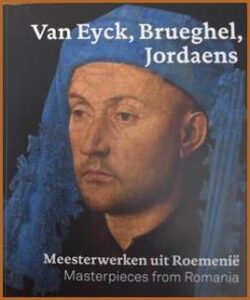 A resolution was adopted by the European Parliament in 2004, reflecting, among other things: The extent to which Russia was also among the Allies at the time may perhaps complicate this issue.
A resolution was adopted by the European Parliament in 2004, reflecting, among other things: The extent to which Russia was also among the Allies at the time may perhaps complicate this issue.
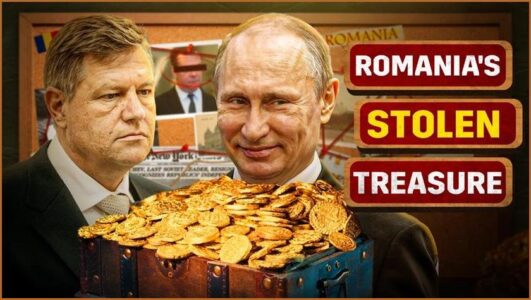
- whereas the total national property legally placed in Russian custody includes 91.5 tons of gold belonging to the reserve of the Romanian National Bank, as well as royal collections of jewelry and rare
coins, as well as assets of cultural and historical value such as state archives, documents, precious historical manuscripts, heritage paintings, rare books and collections of numerous public and private institutions covering more than five centuries of Romanian history; - whereas the total national property legally placed in Russian custody includes 91.5 tons of gold belonging to the reserve of the Romanian National Bank, as well as royal collections of jewelry and rare coins, as well as assets of cultural and historical value such as state archives, documents, precious historical manuscripts, heritage paintings, rare books and collections of numerous public and private institutions covering more than five centuries of Romanian history;
Whether these decisions will be on the agenda of the big Nato meeting to be held in the Netherlands on June 24 and 25 next, where a tour of a number of cities on the theme of peace and security will call at Assen remains to be seen.
Political developments and business
Shifting panels – Romanian elections
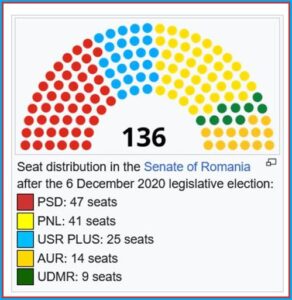 Annoyingly, you were confronted with the topic of elections last year and again this year. Again the mainstream media are unable to interpret what impact the emerging right-wing extremism will have, especially when it comes to bilateral trade agreements.
Annoyingly, you were confronted with the topic of elections last year and again this year. Again the mainstream media are unable to interpret what impact the emerging right-wing extremism will have, especially when it comes to bilateral trade agreements.
That changes are imminent you really do understand, but a human being is naturally inclined to resist change unless the changes are improvements. 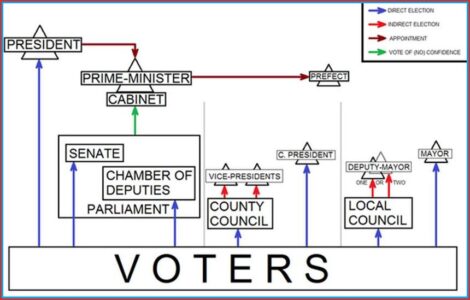
In Europe, but also to a greater and lesser extent in the rest of the world, only one shifting panel can be observed influencing the other panels and that is the emerging right-wing extremism. You might also wonder where the wind is coming from that is moving this panel in a certain direction and the direction can be an opportunity or threat. The choice or consideration is up to you and we would like to support you in that. We assess, with a caveat, the situation in Romania as moderately positive in terms of political stability. For so far, the current coalition of socialists, liberals and the Hungarian minority has managed to keep the right-wing extremist AUR at bay. And a new joint presidential candidate has been appointed. Nevertheless, the propaganda machine of the Russian Federation is running at full speed!!!
Participating in a network organization has great value
Another and perhaps even more important aspect for you is the reason for being a member of a network organization such as the DRN. The typical Dutch question then is what does it cost, but we dare to postulate that it is not the price that is central, but the added value that the DRN delivers to your company. And one outweighs the other.
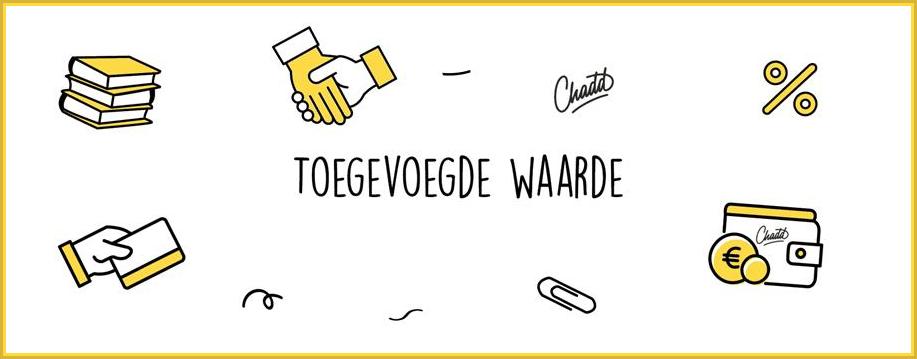
We do this by providing you with relevant information but also by organizing network meetings where you yourself can also have your say and you are really listened to. This year we want to go a step further and pay more attention to you as an individual entrepreneur and that will have an added value.
Will you take that challenge with us? We look forward to welcoming you!
Aviation Sector
Wizz Air expands to Sibiu
 The airline Wizz Air is continuing its expansion in the Romanian market, assigning a new aircraft to its Sibiu base and launching six new routes, according to a press release. Over 320,000 new seats will be made available. Capacity will increase 58% over last summer. From Sibiu, the company will operate flights on 11 routes to six countries and also increase frequencies on three existing routes. From early August 2025, they will operate to Vienna, Hamburg , Frankfurt Hahn , Basel , Rome, Fiumicino and Madrid. In addition, the frequency of flights to Memmingen (daily flights), Nuremberg and Baden-Baden (both served four times a week) will increase . Currently, the airline operates 169 routes from 13 airports in Romania and connects passengers to 72 destinations in 24 countries. Over the past 18 years, Wizz Air has established six operational bases in Bucharest, Cluj-Napoca, Iasi, Timișoara, Craiova and Sibiu. The airline has more than 1,500 employees in Romania. “We are proud to have a 55% share in Romania, an important market for Wizz Air, and to be able to further expand our operations, highlighting our continued commitment to the country, ” said Mauro Peneda, Managing Director of Wizz Air Malta. The company has been operating at Sibiu Airport since 2014. Wizz Air is expanding to Sibiu, adding a new aircraft and launching six new routes,
The airline Wizz Air is continuing its expansion in the Romanian market, assigning a new aircraft to its Sibiu base and launching six new routes, according to a press release. Over 320,000 new seats will be made available. Capacity will increase 58% over last summer. From Sibiu, the company will operate flights on 11 routes to six countries and also increase frequencies on three existing routes. From early August 2025, they will operate to Vienna, Hamburg , Frankfurt Hahn , Basel , Rome, Fiumicino and Madrid. In addition, the frequency of flights to Memmingen (daily flights), Nuremberg and Baden-Baden (both served four times a week) will increase . Currently, the airline operates 169 routes from 13 airports in Romania and connects passengers to 72 destinations in 24 countries. Over the past 18 years, Wizz Air has established six operational bases in Bucharest, Cluj-Napoca, Iasi, Timișoara, Craiova and Sibiu. The airline has more than 1,500 employees in Romania. “We are proud to have a 55% share in Romania, an important market for Wizz Air, and to be able to further expand our operations, highlighting our continued commitment to the country, ” said Mauro Peneda, Managing Director of Wizz Air Malta. The company has been operating at Sibiu Airport since 2014. Wizz Air is expanding to Sibiu, adding a new aircraft and launching six new routes,
Post Craiova – High visit.

It hasn’t happened much in recent years, but recently I was in contact with the Dutch Embassy in Bucharest again after a long time. As a board member of the entrepreneurial platform Dutch Romanian Network, I attended the annual Romanian Business Day on November 21, 2024, at Slot Loevestein. Here, quite by chance, I came into contact with Andrei, a policy officer from the Dutch Embassy in Bucharest. On his way to the meeting he was stranded somewhere at a railway station near Gorinchem and since I was passing by anyway, I gave him an elevator. Afterwards we both had to go to Amsterdam as well, so we had plenty of time to talk. Of course, our conversation quickly turned to the supposed differences and similarities between the Netherlands and Romania. Perhaps not entirely coincidentally, shortly thereafter I was invited by the Dutch ambassador; Mrs. van Haaften. It was about an introductory meeting and about an intended visit of the ambassador to the NetRom campus in Craiova. So no sooner said than done. In a not-quite-so-distant past, when I lived full-time in Romania for a period of more than 17 years, I came into contact with the embassy and consulate much more frequently. I really queued endlessly there to arrange visas, including for my own wife, every time we traveled together to the Netherlands. I stood there on the sidewalk a day after my children were born to arrange their passports (and Dutch citizenship). Very occasionally I drove to Bucharest, which is 500 kilometers there and back, specifically to pick up Dutch Saturday newspapers. Rather inconceivable such a thing, now. When the interview with the ambassador took place, quite coincidentally, the embassy was busy arranging the last vestiges of Romania’s Schengen accession, which would take effect later that same day. Even road traffic and shipping to and from Romania can now continue unhindered. So now the visa requirement of the time really seems to be a thing of the past. Ambassador van Haaften is a professional diplomat and has been to many fascinating places, including several years in the Gaza Strip. A nomadic existence with increasingly important posts abroad, for only a few years each time, because you are not supposed to “take root” anywhere. I don’t think many people have a good idea about the daily activities of diplomats. Neither do I, so the conversation with Ambassador van Haaften was very instructive. By the way, for those who think that diplomats mostly talk a lot and get little done; the permanent, always 25-kilometer truck traffic jam that has existed day-and-night for years between the border crossing between Romania and Bulgaria had disappeared like snow in the sun the day after Schengen accession. A border crossing that took truck drivers two days to cross. I can only guess how countless labor hours were lost here, not even to discuss pollution, nuisance and environmental damage. A great example of the important work done by the Dutch Embassy, among others, to get this done.
For me personally, it has been confirmed again that the Dutch representation in Romania consists of pleasant, correct and competent people who do their work in a well-organized way. A pleasant thought, and once again confirmation that the Netherlands is a really well organized country.
Sector Infrastructure
The map of highways
The map of highways in Romania has become increasingly consistent in recent years, and the nearly 200 kilometers of new highways inaugurated in 2024 have changed many Westerners’ perceptions of Romania. Some look in awe at the changes in the country’s road infrastructure.
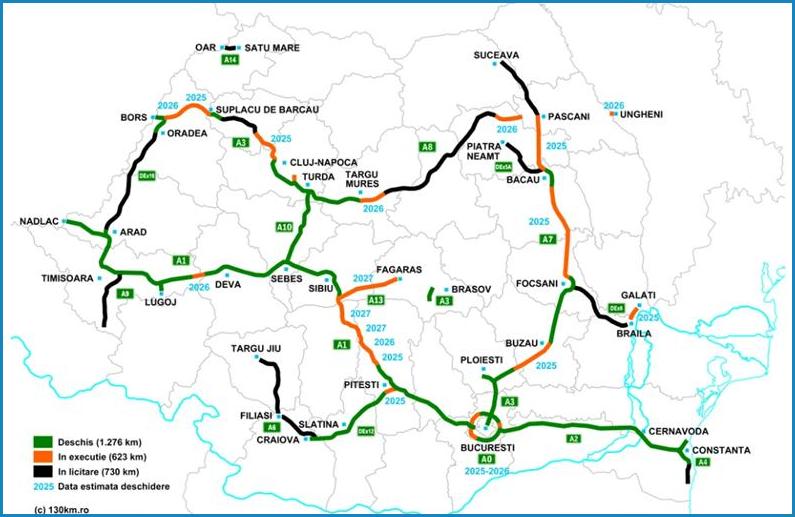
Map of highways in Romania. Source: 130km.ro
In 2024, nearly 200 kilometers of highways were inaugurated in Romania, setting an annual record in the construction of high-speed roads. The new highways have significantly changed Romania’s road map, with the opening of several sections of Moldovan highway. More than 150 kilometers of highways are expected to be completed by 2025, and the pace of construction will be high in the coming years, according to estimates of projects currently under construction of more than 600 kilometers of highways and expressways. The current map of highways and expressways in Romania includes a high-speed road network of nearly 1,300 kilometers, reaching almost all regions, to a lesser extent in the northern part of the country. Most sectors were built from the 2000s, with the help of European funds, and less than 120 kilometers of highways were inaugurated before 1990 by the communist regime led by Nicolae Ceaușescu.
Major impact on highway construction
“Of course the European Union is like a gift from heaven for the less developed countries in Europe, especially when it comes to infrastructure “, believes one Reddit user from Croatia. But this shows that people are not aware of such investments. “In Croatia, the only advertising tool I see that mentions the EU is the sign at the entrance to the construction site. On the other hand, at least in our case, everyone seems to assume that the investment is financed by the EU and therefore no further promotion is needed. However, when it comes to other countries, I wouldn’t bet on it, especially when I look at the people representing them who claim they can do without the EU, ” she writes.
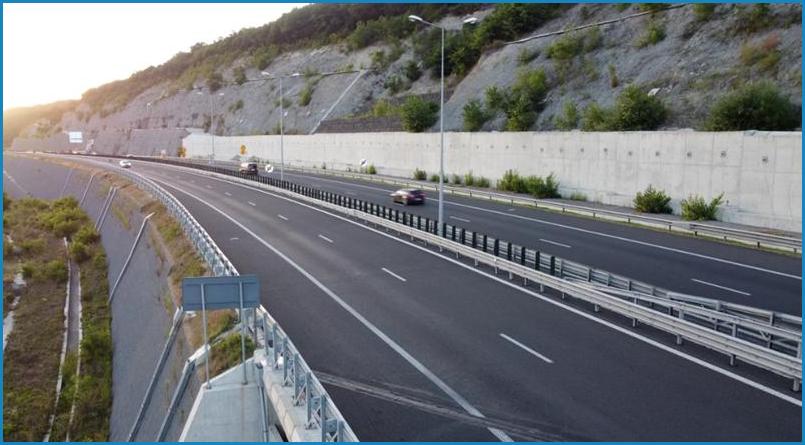
However, some foreigners believe that more highways should be extended to the borders with neighboring states. Currently, only the A1 reaches Nădlac. “Soon we will build highways to Moldova and Ukraine” , believes a Romanian. However, some Westerners complain that the highways do not reach the Danube border with Bulgaria. “It would be even better if the routes were extended to the bridges over the Danube to connect with Bulgaria. You are now in Schengen and international traffic will increase” , believes another Westerner. Some Europeans believe the European Union should prioritize infrastructure investment funding differently, focusing more on rail.
Sector Culture
Cultural Entrepreneurship and Government
Tomorrow’s entrepreneurs must understand culture if they are to be effective influencers. Or using softpower to persuade others.
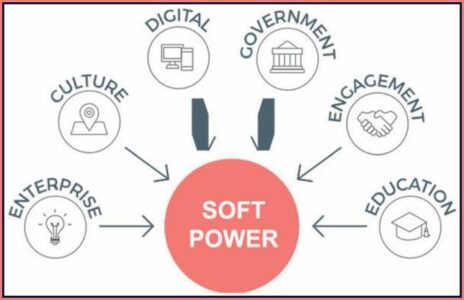 Below is a message from the entrepreneur and conductor/producer Raymond Janssen and known to many DRN members. And where the DRN awarded the Romanian Business Award years ago for how he has shaped cultural entrepreneurship. DRN editors refer to Churchill as a leader of hard power with a soft power underbelly. With his image, his writing and his rhetoric, the great warlord and leader was as much an overeater as a fighter. Churchill made soft power sing … he made soft power work.’ Art and culture are invaluable to a society. For any society! In times of prosperity and prosperity but certainly also during crises! When the cabinet of Winston Churchill, British Prime Minister during World War II, proposed to free up extra money for the war by cutting back on arts and culture, Churchill is reported to have said, “But then what are we fighting for? Soft power has always been important to foreign policy. But this is more true than ever in today’s globalized, digital age, where mass communication has vastly expanded the ability of artists, writers and other leaders to communicate with millions of people around the world. With the power to exert influence spreading from elites and more interactions taking place at a human-to-human level, the ability of individuals to influence culture and of culture to influence individuals has never been greater. As Churchill prophetically put it in 1943, “The empires of the future are empires of the mind.
Below is a message from the entrepreneur and conductor/producer Raymond Janssen and known to many DRN members. And where the DRN awarded the Romanian Business Award years ago for how he has shaped cultural entrepreneurship. DRN editors refer to Churchill as a leader of hard power with a soft power underbelly. With his image, his writing and his rhetoric, the great warlord and leader was as much an overeater as a fighter. Churchill made soft power sing … he made soft power work.’ Art and culture are invaluable to a society. For any society! In times of prosperity and prosperity but certainly also during crises! When the cabinet of Winston Churchill, British Prime Minister during World War II, proposed to free up extra money for the war by cutting back on arts and culture, Churchill is reported to have said, “But then what are we fighting for? Soft power has always been important to foreign policy. But this is more true than ever in today’s globalized, digital age, where mass communication has vastly expanded the ability of artists, writers and other leaders to communicate with millions of people around the world. With the power to exert influence spreading from elites and more interactions taking place at a human-to-human level, the ability of individuals to influence culture and of culture to influence individuals has never been greater. As Churchill prophetically put it in 1943, “The empires of the future are empires of the mind.
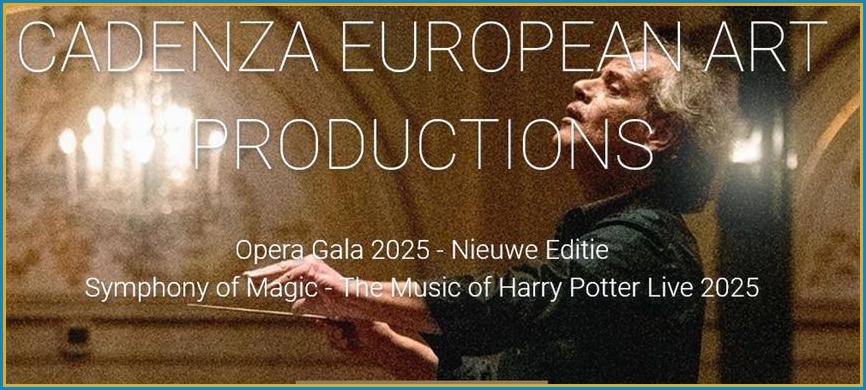
The arts are ideally suited to connect with large global audiences and influence people on a deep emotional level. Increasingly, they do so beyond the reach of political elites. Indeed, attempts by politicians throughout history to use the arts instrumentally have tended to fail. It is the nature of cultural connections that they are incremental and of artistic responses that they are indirect. Countries that seek to control their creative output are often seen as indulging in cultural bragging or propaganda. Those who support their creative output from a distance acquire greater international influence through the resulting soft power.
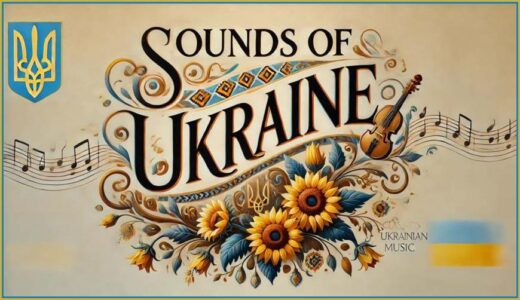 Conductor Raymond Janssen’s mission is to bring Eastern Europe and Western Europe closer together. The rich tradition from Eastern European countries can be heard and felt, and everyone should know that! This time he has focused on Ukraine a country at War can certainly use support in the field of culture and also has a lot to offer (see the program at https://cadenza-productions.nl/. He also managed to contract the world-famous Romanian tenor REMUS ALĂZĂROAE who celebrated triumphs at the Puccini Year in Korea last year. However, he is concerned about the decline of the cultural sector in Romania the country with which he has maintained contacts for 12 years and where he received an award from the President of Romania from the hands of the Romanian ambassador during a performance at the Amsterdam Concertgebouw. The DRN hopes and trusts that the negative trend in Romania will turn for the better!
Conductor Raymond Janssen’s mission is to bring Eastern Europe and Western Europe closer together. The rich tradition from Eastern European countries can be heard and felt, and everyone should know that! This time he has focused on Ukraine a country at War can certainly use support in the field of culture and also has a lot to offer (see the program at https://cadenza-productions.nl/. He also managed to contract the world-famous Romanian tenor REMUS ALĂZĂROAE who celebrated triumphs at the Puccini Year in Korea last year. However, he is concerned about the decline of the cultural sector in Romania the country with which he has maintained contacts for 12 years and where he received an award from the President of Romania from the hands of the Romanian ambassador during a performance at the Amsterdam Concertgebouw. The DRN hopes and trusts that the negative trend in Romania will turn for the better!
We encourage you to reserve tickets through the website (mentioned above) as the tour will take place from March 13-23!
Agricultural sector
DN AGRAR and BSOG Energy sign cooperation agreement for Romania’s largest biomethane production facility
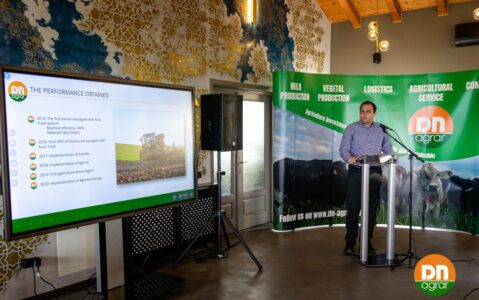 DN AGRAR Group, the largest integrated livestock producer in Romania, and BSOG Energy, an energy company focused on developing biomethane production facilities throughout Romania, recently signed a cooperation agreement for the largest biomethane production facility in Romania, with a total capacity of up to 15 MW. The agreement has a term of 15 years. DN AGRAR will supply the feedstock for biomethane production and BSOG Energy will develop the facility. The development of the facility is expected to take two years. Along with the compost plant that will be commissioned in the second half of the year, the biomethane production is part DN AGRAR’s development strategy direction to further expand and diversify its business, focusing on sustainability. “We expect this will allow us to reduce carbon monoxide emissions by 90%, while developing economic opportunities and creating additional jobs. Our biomethane, compost and solar projects together can bring us close to ‘zero emmission”and enable further expansion of our core business,” said Peter de Boer, board member and IR manager of DR AGRAR Group.
DN AGRAR Group, the largest integrated livestock producer in Romania, and BSOG Energy, an energy company focused on developing biomethane production facilities throughout Romania, recently signed a cooperation agreement for the largest biomethane production facility in Romania, with a total capacity of up to 15 MW. The agreement has a term of 15 years. DN AGRAR will supply the feedstock for biomethane production and BSOG Energy will develop the facility. The development of the facility is expected to take two years. Along with the compost plant that will be commissioned in the second half of the year, the biomethane production is part DN AGRAR’s development strategy direction to further expand and diversify its business, focusing on sustainability. “We expect this will allow us to reduce carbon monoxide emissions by 90%, while developing economic opportunities and creating additional jobs. Our biomethane, compost and solar projects together can bring us close to ‘zero emmission”and enable further expansion of our core business,” said Peter de Boer, board member and IR manager of DR AGRAR Group.

BSOG Energy, owned by Black Sea Oil & Gas, even expects to eventually expand the plant’s capacity to 20 MW. Since Jan and Peter de Boer already enjoyed increasing interest in the past year, the DRN editors will think along with them and keep you informed of relevant information, which, by the way, is already available see DN AGRAR GROUP S.A.
Romania still has 2.8 million small farms – the largest number in Europe
Recent figures from the National Institute of Statistics (INS) confirm the country’s strong agricultural profile, with more than 2.8 million farms. It is safe to say that 1 in 3 EU farms is a Romanian farm. Although the contribution of agriculture to GDP is limited in purely economic terms, the huge proportion of the population dependent on this sector ensures that its importance goes far beyond economic figures. The more extensive, traditional type of agriculture practiced by these farms has also made a positive contribution to the balance between agriculture and nature in Romania. In 2023, the number of farms decreased by 1% and the area used for agriculture by 1.7%, compared to the 2020 General Census of Agriculture, according to INS data.
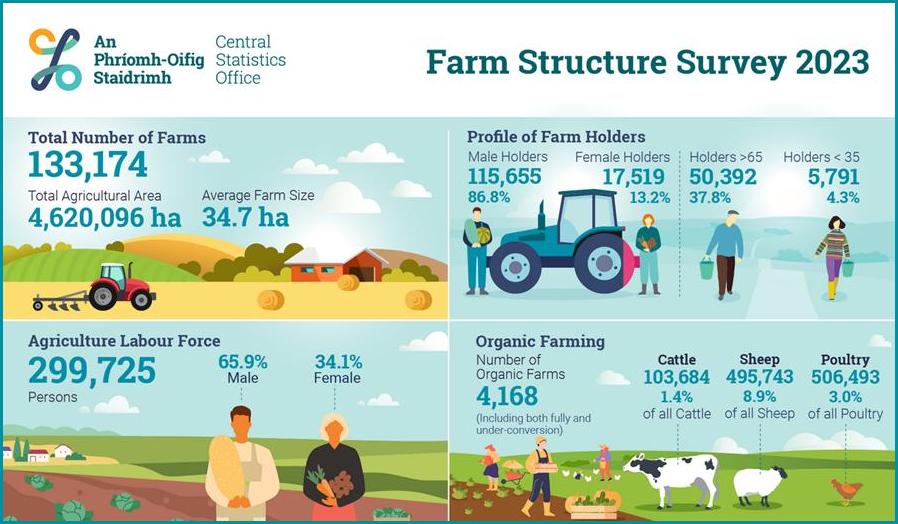
If there were 2.887 million farms in Romania in 2020, three years later their number stood at 2.859 million, of which 2.834 million were unincorporated and 25,000 were incorporated. The number of incorporated farms remained the same in 2023 as in 2020. These figures show little structural adjustment over the past 3 years. According to the Farm Structure Survey results, a total of 2.859 million farms used 12.55 million hectares of farmland in the reference year 2023. The average area of utilized farmland per farm in 2023 was 4.39 hectares, compared to 4.42 hectares in 2020. By farm category, the average area of utilized agricultural land per unincorporated farm in 2023 was 2.74 ha, compared with 2.73 ha in 2020. Similarly, the average area of utilized farmland per incorporated farm was 190.51 ha, compared to 194.78 ha in 2020.
The INS data also show that the number of very small farms, which used an agricultural area of up to one hectare, decreased by 1.3% in 2023 compared to 2020. Both farms using less than 0.5 hectares of agricultural area (37.3% of all farms) and those using between 0.5 and 1 hectare of agricultural area (16.3% of all farms) contributed to this decrease. Much of the utilized agricultural area, 47%, was owned by users last year. Specifically, 36.8% of the utilized agricultural area was owned by unincorporated farms and 10.2% by incorporated farms.
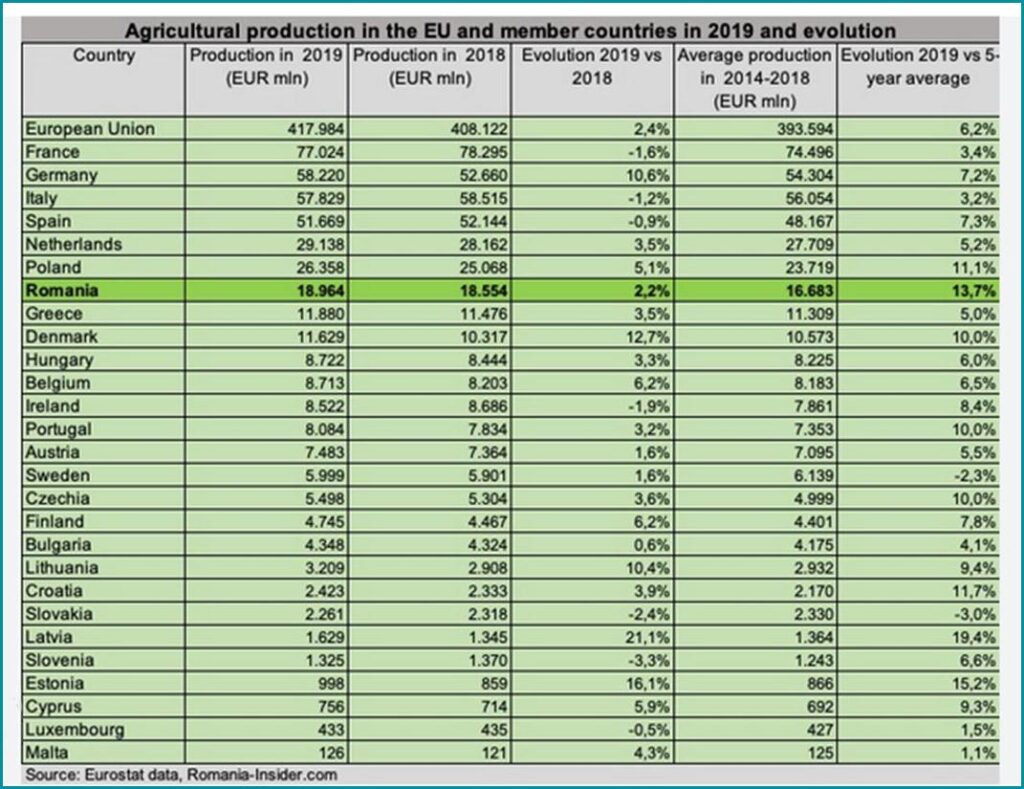
Compared with 2020, in 2023 the area used as arable land (including greenhouses) decreased by 1%, the area used as pastures and meadows by 2.9% and the area used as permanent crops by 5.4%. Last year, the area used as arable land decreased to 8.483 million ha (from 8.571 million ha in 2020), pastures and meadows covered 3.617 million ha (3.724 million ha in 2020), permanent crops 325,000 ha (344,000 ha in 2020) and family farms occupied a slightly increasing area of 125,000 ha (compared to 124,000 ha in 2020). While the engine of modernization lies with the larger commercial farms (basically the 25,000 incorporated farms), the value of the smaller family farms is indisputable from a social and environmental perspective. Romania can and should play a greater role in food production and food security in Europe, as there is still much room for further development in this region. Sustainable development, of course
Financial Economic Sector
Interest rate reduction and lending
Only one-fifth (21%) of chief financial officers (CFO) at companies find bank financing attractive, while a double portion, 44% of CFOs, believe equity financing is attractive and 44% of them also consider internal financing attractive , according to the Deloitte CFO Survey Romania 2025 study.
 “In terms of available sources of financing, Romanian financial directors identify internal financing and equity financing as the most attractive financing alternatives, while bank loans and financing through corporate bonds remain less attractive,” said Zeno Căprariu, audit partner at Deloitte Romania, the CFO program coordinator in Romania, during the annual Deloitte CFO Summit conference held in cooperation with ZF. A third (33%) of CFOs in companies find loans from banks unattractive, while only 10-11% of CFOs in companies consider internal financing and financing through capital contributions, respectively, as unattractive, according to the survey. In Romania, there is a very complicated relationship between the banking system and companies because companies need loans to finance their operations and investments. The still high interest in lei is an important element limiting companies’ interest in bank loans. Under these circumstances, lowering interest rates is absolutely necessary to revive lending and stimulate the economy.
“In terms of available sources of financing, Romanian financial directors identify internal financing and equity financing as the most attractive financing alternatives, while bank loans and financing through corporate bonds remain less attractive,” said Zeno Căprariu, audit partner at Deloitte Romania, the CFO program coordinator in Romania, during the annual Deloitte CFO Summit conference held in cooperation with ZF. A third (33%) of CFOs in companies find loans from banks unattractive, while only 10-11% of CFOs in companies consider internal financing and financing through capital contributions, respectively, as unattractive, according to the survey. In Romania, there is a very complicated relationship between the banking system and companies because companies need loans to finance their operations and investments. The still high interest in lei is an important element limiting companies’ interest in bank loans. Under these circumstances, lowering interest rates is absolutely necessary to revive lending and stimulate the economy.
Union of Romanian Principalities. Past glory or a new beginning?
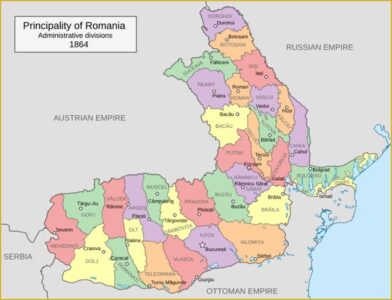 Happy birthday, Romania! 166 years since the Union of the Romanian Principalities. In this context, it is interesting to extrapolate the map of the economic power of the principalities from 1859, to 2025. The map of Romania’s two principalities, and the counties that were part of them 166 years ago, still shows a slow pace of development and the differences between them are great. From an economic point of view, Iasi did not want to move the capital of the new country formed in 1859 to Bucharest. And they were right about that. Iasi and the Moldova region lost their rate of development after the Little Union in favor of Bucharest as the economic center moved to the capital. Obviously, a capital attracts investment, labor and development, and Iasi lost speed after unification. After the moment of unification, for example, housing prices in Moldova fell and Iasi and the region attracted fewer investors. However, the agreement at the time was that Iasi would remain the cultural and religious capital. So the patriarch of Romania comes from metropolitan Moldova and Bukovina, although the Romanian patriarchate is based in Bucharest. The cumulative gross regional product of Muntenia and Oltenia, part of Wallachia in 1859, is 406 billion lei. The current provinces that in 1859
Happy birthday, Romania! 166 years since the Union of the Romanian Principalities. In this context, it is interesting to extrapolate the map of the economic power of the principalities from 1859, to 2025. The map of Romania’s two principalities, and the counties that were part of them 166 years ago, still shows a slow pace of development and the differences between them are great. From an economic point of view, Iasi did not want to move the capital of the new country formed in 1859 to Bucharest. And they were right about that. Iasi and the Moldova region lost their rate of development after the Little Union in favor of Bucharest as the economic center moved to the capital. Obviously, a capital attracts investment, labor and development, and Iasi lost speed after unification. After the moment of unification, for example, housing prices in Moldova fell and Iasi and the region attracted fewer investors. However, the agreement at the time was that Iasi would remain the cultural and religious capital. So the patriarch of Romania comes from metropolitan Moldova and Bukovina, although the Romanian patriarchate is based in Bucharest. The cumulative gross regional product of Muntenia and Oltenia, part of Wallachia in 1859, is 406 billion lei. The current provinces that in 1859
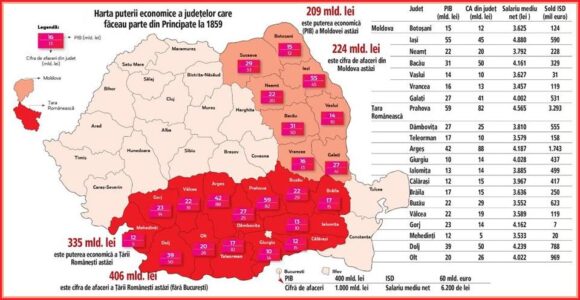 Moldova formed would have a combined gross regional product of 224 billion lei. This calculation excludes Bucharest, which distorts the data. But former Wallonia’s gross regional product is almost twice that of former Moldova, even if Bucharest’s contribution is not included. The celebration of the Union of the Principalities in 2025 comes at a time when, for the first time in the past 166 years, Bucharest is on the verge of uniting with Iasi via a high-speed highway: the Moldovan Highway, built within the National Recovery and Resilience Plan (PNRR) and the highway connecting Oltenia to Muntenia. It is inevitable that better infrastructure, in this case a highway connection, will bring more development to both Iaşi and the Moldova region.
Moldova formed would have a combined gross regional product of 224 billion lei. This calculation excludes Bucharest, which distorts the data. But former Wallonia’s gross regional product is almost twice that of former Moldova, even if Bucharest’s contribution is not included. The celebration of the Union of the Principalities in 2025 comes at a time when, for the first time in the past 166 years, Bucharest is on the verge of uniting with Iasi via a high-speed highway: the Moldovan Highway, built within the National Recovery and Resilience Plan (PNRR) and the highway connecting Oltenia to Muntenia. It is inevitable that better infrastructure, in this case a highway connection, will bring more development to both Iaşi and the Moldova region.
Disclaimer

The newsletter of the Dutch Romanian Network is compiled with great care. The Dutch Romanian Network cannot accept any liability for a possible inaccuracy and/or incompleteness of the information provided herein, nor can any rights be derived from the content of the newsletter. The articles do not necessarily reflect the opinion of the board.
